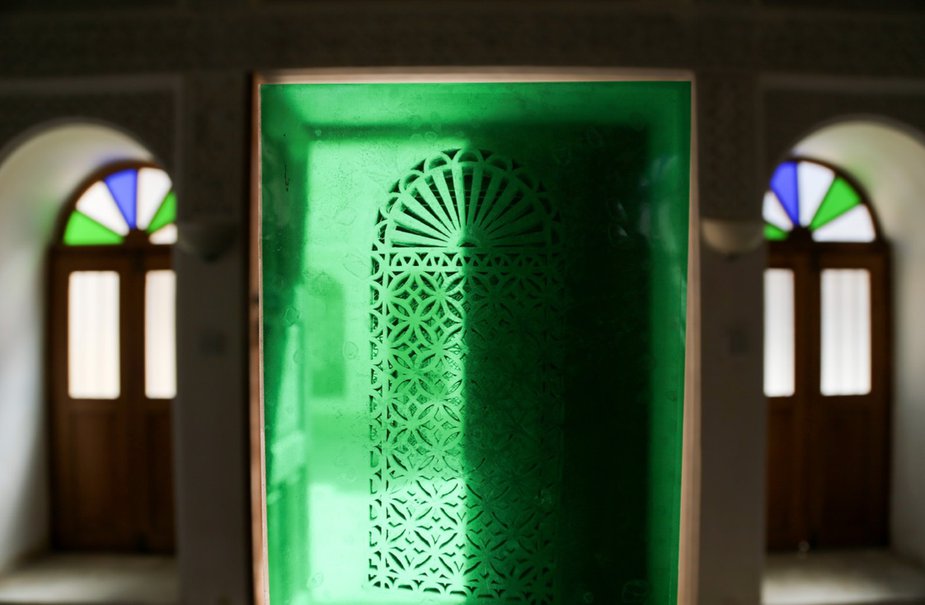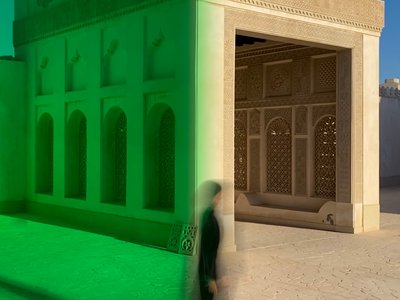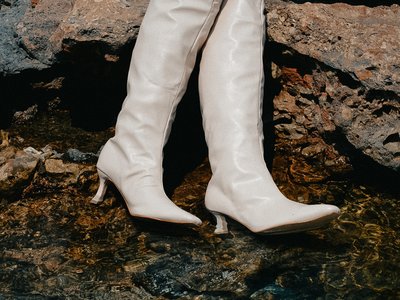Maryam Hassan Al-Thani:
The convergence of photography and architecture has been a recurring theme in your practice – in a previous exhibition called Here/There and during your residency at Doha’s Fire Station, and now in your installation at Al Rayyan Palace as part of Tasweer’s inaugural programme. Can you say more about this meeting of photography and the spatial in your work?
Shaha Al Khulaifi:
I was really interested in developing photography from a traditionally 2D medium into 3D space – kind of like translating architectural space into the way I’m exhibiting my work. I began exploring different materials and discovered that printing images onto and into layers of glass achieved that spatial effect for me. I wanted to add more depth to the images – adding a third layer – and making that integral to the viewing experience. I decided to incorporate materials such as glass and mirror. There are some explorations with mirror that I have never exhibited, but I used to also work with printing on mirror. Using different materials such as mirror and glass, and achieving the projection effect with lighting, the glass kind of added a third element to the work. I was really interested in doing that, and I continued to incorporate that method in my works after the Here/There exhibition, currently at Al Rayyan Palace. Exploring the palace architecturally really inspired me to continue with the medium as a way of mimicking the shadows and lighting within the palace and creating a space – creating a third element to the 2D photographic prints.
Maryam Hassan Al-Thani:
You like to work with materials that create forms that change. Did your interests start with architecture and then you went into thinking of ways to document space with photography, or did it start with this exploration of materiality? Were you interested in spaces and that translated into your own artistic practice of image-making?
Shaha Al Khulaifi:
It definitely was documenting architecture for me. It was more about archiving and witnessing how the city of Doha is changing, and places that are undergoing construction and makeovers. That was the main staring point, but I’ve always been interested in spaces within the built environment and in creating spaces, so I wanted to combine the two together – documenting architecture while also presenting creating a space for it. And exactly as you mentioned – with my incorporation of different materials – I am in dialogue with the architecture of the city. New construction is typically glass buildings with reflective windows – kind of a mirror effect, where light is a really important feature in architecture and defines what a building looks like. My installation work adds that element to it.
Maryam Hassan Al-Thani:
As an artist, what was your first reaction to the space at Al Rayyan Palace? When we first went on site visits, was there something specific that struck you?
Shaha Al Khulaifi:
It was overwhelming when I first entered the palace – the beauty of it is overwhelming. It’s a masterpiece all on its own. And even not knowing the historical context or the stories behind it at that point, you just wanted to be there and silently observing the beauty of it. As a building, it’s really impactful and I think it’s one of the most important examples of Qatari architecture. It puts a huge responsibility on me to respect and to keep the integrity of the building, and to try not to disrupt it in any way with my installation works. I wanted to continue documenting the building itself and just highlighting the features of the building – the plaster work, the latticework, the Mashrabiyas [latticed window], the arches – all these architectural features of the building were extremely beautiful. I couldn’t ignore them, I had to highlight them. The concept of my works as a contemporary reflection upon the buildings and their qualities. I wanted to play with one of the features of the palace – the tinted glass on the windows that’s a feature of traditional Qatari houses. I wanted to add a “pop” of color – emphasizing these tinted glass windows and enlarging them while also incorporating the image work into these installations. It’s a celebration of local Qatari architecture. I didn’t focus on the historical, anecdotal stories of the palace but rather the aesthetics of the building itself.


